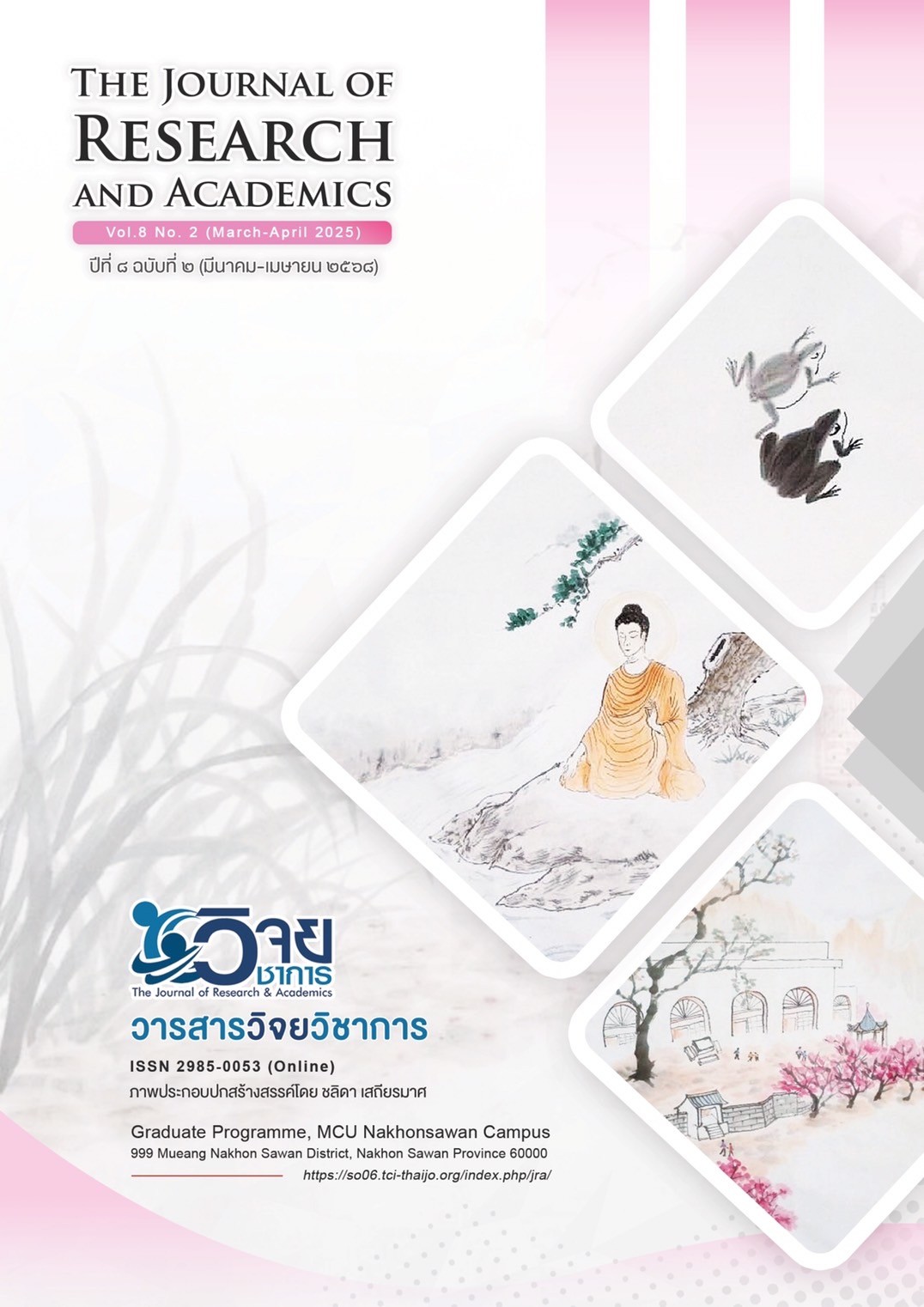Learning Management with 5 Steps Collaborative Learning Process on Geographic Tools and World Time of Matthayomsuksa 1 Students at Srinaphakhet Wittaya School, Takfa District, Nakhon Sawan Province
Main Article Content
Abstract
The objectives of this research article were 1) to develop and find the efficiency of learning management with 5-step collaborative learning process on Geographic Tools and World Time of Mathayomsuksa 1 students at Srinaphakhet Wittaya School according to the criteria of 80/80; 2) to compare the learning achievement before and after learning with the 5-step collaborative learning process; and 3) to study the satisfaction of students with the 5-step collaborative learning process. This was an experimental research. The research instruments included learning management plan with 5-step collaborative learning process, 6 plans, 40-item pre- and post-learning achievement test, and 10-item student satisfaction questionnaire with the 5-step collaborative learning process. Data analysis included percentage, mean, standard deviation, and comparison of achievement before and after learning using the independent mean comparison test. The research results found that 1) the results of the development and efficiency of learning management with the 5-step collaborative learning process on Geographic Tools and World Time of Mathayomsuksa 1 students found that the development of learning management with the 5-step collaborative learning process in all 6 plans was at the most appropriate level and had an overall efficiency (E1/E2) of 92.12/90.22; 2) the results of the comparative test of learning achievement with the 5-step collaborative learning process found that the students' learning achievement after studying was higher than before studying; 3) the results of the study of satisfaction in using the 5-step collaborative learning process found that students were satisfied with using the 5-step collaborative learning process at the highest level overall.
Article Details

This work is licensed under a Creative Commons Attribution-NonCommercial-NoDerivatives 4.0 International License.
1. เนื้อหาและข้อมูลในบทความที่ลงพิมพ์กับวารสารวิจยวิชาการ ถือเป็นข้อคิดเห็น และความรับผิดชอบของผู้เขียนบทความโดยตรงซึ่งกองบรรณาธิการวารสารไม่จำเป็นต้องเห็นด้วย หรือร่วมรับผิดชอบใด ๆ
2. บทความ ข้อมูล เนื้อหา รูปภาพ ฯลฯ ที่ได้รับการตีพิมพ์ในวารสารวิจยวิชาการ ถือเป็นลิขสิทธิ์ของวารสารวิจยวิชาการ หากบุคคลหรือหน่วยงานใดต้องการนำทั้งหมดหรือส่วนหนึ่ง ส่วนใดไปเผยแพร่ต่อหรือเพื่อการกระทำการใด ๆ จะต้องได้รับอนุญาตเป็นลายลักษณ์อักษรจากวารสารวิจยวิชาการก่อนเท่านั้น
References
กระทรวงศึกษาธิการ. (2551). ตัวชี้วัดและสาระการเรียนรู้แกนกลางกลุ่มสาระการเรียนรู้สังคมศึกษาศาสนาและวัฒนธรรมตามหลักสูตรแกนกลางการศึกษาขั้นพื้นฐานพุทธศักราช 2551. กรุงเทพฯ : โรงพิมพ์ชุมนุมสหกรณ์การเกษตรแห่งประเทศไทย.
ชญานิศ ดวงระหว้า. (2560). การพัฒนากิจกรรมการเรียนรู้โดยใช้กระบวนการเรียนรู้ 5 STEPs เรื่องปรัชญาของเศรษฐกิจพอเพียง กลุ่มสาระการเรียนรู้สังคมศึกษา ศาสนา และวัฒนธรรม ชั้นประถมศึกษาปีที่ 4. (วิทยานิพนธ์ครุศาสตรมหาบัณฑิต สาขาวิชาหลักสูตรและการเรียนการสอน). บัณฑิตวิทยาลัย : มหาวิทยาลัยราชภัฏมหาสารคาม.
ธัญญารัตน์ สุขเกษม, กิตติมา พันธ์พฤกษา และนพมณี เชื้อวัชรินทร์. (2562). ผลการจัดการเรียนรู้แบบกระบวนการเรียนรู้ 5 ขั้นตอน (5 STEPs) ร่วมกับการใช้คำถามเชิงวิเคราะห์ เรื่อง วิวัฒนาการ ที่มีต่อการคิดวิเคราะห์ทางวิทยาศาสตร์ และผลสัมฤทธิ์ทางการเรียน ของนักเรียนชั้นมัธยมศึกษาปีที่ 4. ศึกษาศาสตร์สาร, 3(2), 24-36.
ธัญมาศ นางาม. (2561). ผลการใช้บทเรียนคอมพิวเตอร์ช่วยสอนเพื่อเสริมการเรียนรู้วิชาคณิตศาสตร์ เรื่อง ระบบจำนวนเต็ม สำหรับนักเรียนชั้นมัธยมศึกษาปีที่ 1. (วิทยานิพนธ์วิทยาศาสตรมหาบัณฑิต สาขาวิชาคณิตศาสตร์). บัณฑิตวิทยาลัย : มหาวิทยาลัยราชภัฏอุบลราชธานี.
พิมพันธ์ เดชะคุปต์ และพเยาว์ ยินดีสุข. (2557). การจัดการเรียนรู้ในศตวรรษที่ 21. กรุงเทพฯ : โรงพิมพ์แห่งจุฬาลงกรณ์มหาวิทยาลัย.
สุธินันท์ อมรเตชพันธ์. (2565, 23 สิงหาคม). การเรียนรู้ในหน่วยการเรียนรู้ที่อยากแก้ไขปัญหาในรายวิชาสังคมศึกษา. (ภัสราภรณ์ งามสมจันทร์, ผู้สัมภาษณ์).
สุพัตรา ศิริเมืองราช และฐาปนี สีเฉลียว. (2565). ผลการจัดการเรียนการสอนด้วยเว็บไซต์ตามวัฏจักรการสืบเสาะหาความรู้ 5 ขั้น เพื่อพัฒนาการคิดเชิงระบบ วิชาวิทยาการคํานวณ สำหรับนักเรียนชั้นประถมศึกษาปีที่ 5. วารสารเทคโนโลยีและสื่อสารการศึกษา คณะศึกษาศาสตร์ มหาวิทยาลัยมหาสารคาม, 5(14), 129-139.

